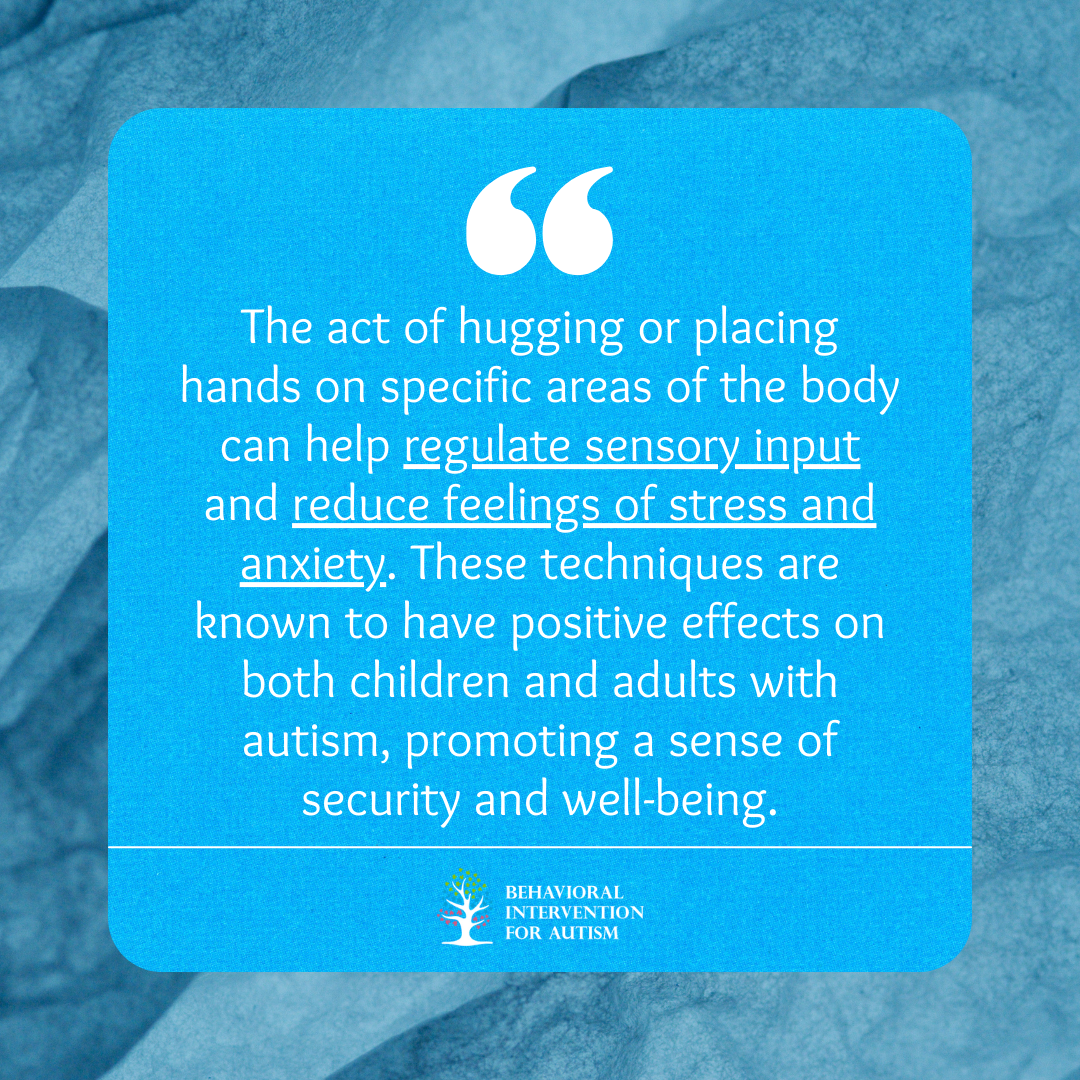
Table of Contents
Deep pressure therapy involves applying firm, gentle pressure to the body, aiming to soothe sensory sensitivity.
This therapeutic approach can significantly benefit individuals with autism or sensory processing challenges by promoting relaxation and improving overall well-being.
Definition and Purpose of Deep Pressure Therapy
Deep pressure therapy is a therapeutic approach that involves the application of touch or weight to aid individuals with sensory sensitivity, including those experiencing stress, anxiety, or sensory overload. This technique aims to provide a calming and organizing effect on the individual’s nervous system by regulating sensory input.
Deep pressure therapy is widely used to assist autistic individuals, both children and adults, in managing sensory issues and promoting a sense of security and comfort. By applying targeted pressure through various methods, deep pressure therapy seeks to enhance the individual’s sensory processing and overall well-being.
Impact on Sensory Sensitivity
One significant benefit of deep pressure therapy is its positive impact on sensory sensitivity, particularly in autistic individuals. This therapy assists in balancing the proprioceptive sense, which is crucial for determining one’s body position in space. By providing deep touch pressure through techniques like weighted blankets or clothing, individuals can experience a soothing and grounding effect, helping them feel more aware of their bodies and surroundings.
Moreover, deep pressure therapy has been shown to influence the autonomic nervous system, playing a role in regulating essential body functions. By promoting relaxation and reducing arousal levels, this therapy may help in decreasing stress and anxiety in individuals with autism or sensory processing disorders.
The application of deep touch pressure therapy can enhance body awareness, alleviate sensory processing difficulties, and trigger a calming reflex in those overwhelmed by sensory stimuli. By stimulating the release of neurotransmitters like dopamine and serotonin, deep pressure therapy can foster a sense of well-being and tranquility, contributing to a reduction in stress and anxiety levels for individuals with sensory sensitivities.
Techniques for Deep Pressure Therapy
Deep pressure therapy employs various techniques to provide sensory input and promote calmness and security for individuals with autism spectrum disorder.
Common methods include hugs and hand placement, along with the use of weighted clothing and vests.
Hugs and Hand Placement
One of the fundamental techniques in deep pressure therapy involves the application of gentle pressure through hugs and hand placement. This form of therapy utilizes touch as a means of providing comfort and relaxation to individuals experiencing sensory sensitivity or overload, particularly those with autism.

In addition to hugs and hand placement, other methods such as massages using tools like body rollers can also be incorporated into deep pressure therapy routines. These tactile interventions can offer a soothing and grounding experience for individuals with sensory processing difficulties.
Weighted Clothing and Vests
Weighted clothing, including vests and jackets, as well as pressure vests (compression vests), are commonly used in deep pressure therapy for individuals who may not be comfortable with direct touch. The application of weighted items provides a constant and evenly distributed pressure across the body, creating a calming and organizing effect on the sensory system.
Research studies have shown that the use of weighted vests and blankets can effectively reduce anxiety levels and improve sensory modulation in individuals with autism spectrum disorder and sensory processing disorder. The deep touch pressure provided by these garments can help individuals regulate their sensory responses and increase feelings of security and comfort.
Benefits of Deep Pressure Therapy
Exploring the advantages of implementing deep pressure therapy for individuals on the autism spectrum reveals significant benefits related to proprioceptive sense balance and the calming effects leading to stress reduction.
Proprioceptive Sense Balance
Deep pressure therapy plays a critical role in assisting individuals with autism in balancing their proprioceptive sense, which is essential for understanding where they are positioned in space. By providing deep tactile pressure through techniques like hugs, hand placements, massages, and the use of tools such as body rollers, individuals receive sensory input that aids in proprioceptive awareness. This enhanced sense of body position and movement can contribute to improved coordination, motor planning, and self-regulation in daily activities.
Calming Effects and Stress Reduction
For individuals with autism, deep pressure therapy offers calming effects that help alleviate sensory sensitivities and reduce stress and anxiety levels. The application of deep touch pressure, whether through hugs, weighted clothing like vests and jackets, or pressure vests, can have a soothing impact on an individual who may be overwhelmed by sensory input. By providing firm and consistent sensory input to the body, deep pressure therapy assists in calming the central nervous system, promoting relaxation, and aiding in the processing of sensory information. This can lead to a reduction in sensory overload, anxiety, and hyperactivity, fostering a more peaceful and regulated state for individuals on the autism spectrum.

Physiological Effects of Deep Pressure Therapy
Exploring the physiological impacts of deep pressure therapy can provide valuable insights into its therapeutic benefits for individuals with autism and sensory processing issues.
Two key aspects to consider are neurotransmitter regulation and the influence on the autonomic nervous system.
Neurotransmitter Regulation
Deep pressure therapy techniques play a pivotal role in regulating neurotransmitters in the brain, such as dopamine. By applying deep pressure to the body, this sensory input triggers the release of dopamine, a neurotransmitter associated with feelings of pleasure and reward. The stimulation of dopamine production through deep pressure therapy can contribute to a sense of calmness and well-being in individuals with autism or sensory processing disorders.
Impact on Autonomic Nervous System
Deep pressure therapy has the potential to influence the autonomic nervous system, which controls involuntary body functions like heart rate, digestion, and stress response. By providing deep pressure input, this therapy modulates the autonomic nervous system, potentially leading to decreased arousal levels and reduced stress and anxiety. Moreover, deep pressure therapy may facilitate the production of neurotransmitters like serotonin, which is linked to mood regulation and emotional well-being.
A notable study published in the Journal of Medical and Biological Engineering in 2011 highlighted the positive effects of deep pressure touch interventions on individuals with high levels of anxiety or arousal. The study found that these interventions act as calming agents, increasing activity in the parasympathetic division of the autonomic nervous system. Specifically, the use of weighted blankets was found to be beneficial in lowering anxiety levels and promoting better sleep quality among participants.

Individualized Approach to Deep Pressure Therapy
Deep pressure therapy for individuals with autism and sensory processing disorders requires an individualized approach that considers each person’s unique needs and responses.
Tailoring the therapy to specific requirements can significantly enhance its effectiveness and positively impact sensory sensitivities.
Tailoring Therapy Needs
In tailoring deep pressure therapy, it’s important to understand the sensory preferences and sensitivities of individuals with autism. By recognizing the specific triggers and responses to sensory inputs, caregivers and therapists can customize the therapy to suit the individual’s comfort level and sensory profile.
One size does not fit all when it comes to deep pressure therapy. Some individuals may respond well to firm pressure, while others may prefer lighter touch. Adjusting the intensity, duration, and application methods of deep pressure can help create a more personalized and effective therapeutic experience.
Response Variability and Considerations
Response variability is common in deep pressure therapy for individuals with autism, influenced by factors like anxiety, sensory thresholds, and environmental stimuli. Understanding these variations is crucial for optimizing therapy benefits.
Research shows that deep pressure therapy can calm autistic individuals, particularly those with high anxiety levels, and while effects may vary and take time to manifest, it can help regulate sensory processing and promote long-term calmness.
One notable technique within deep pressure therapy is the use of a “squeeze machine,” popularized by Dr. Temple Grandin. This method has shown positive results in reducing anxiety and promoting relaxation in individuals with autism and sensory processing disorders.
Deep pressure therapy can be a powerful tool for individuals with autism, providing calming sensations that help reduce anxiety and promote relaxation. This therapeutic approach can complement various strategies, including our specialized ABA programs in Florida.
Our dedicated team at Behavioral Intervention for Autism focuses on creating a nurturing and effective environment that caters to the unique needs of each individual. We are committed to delivering high-quality, personalized interventions that support development and well-being. If you’re interested in discovering how our services can make a positive impact, reach out to us today and let’s explore the possibilities together.
- 9 Common Obsessions of Children With Autism You Should Know - February 25, 2025
- What is Neurodiversity? A Guide to Embracing Differences - February 25, 2025
- Understanding Hyperfocus in Autism: What It Means and Why It Happens - February 25, 2025
